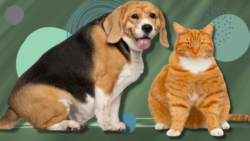A pet’s weight can seriously impact their health (Picture: Getty)
We all love our pets – the problem is, sometimes we love them a little too much.
It’s can be difficult to say no to a dog begging at the dinner table, and woe betide anyone that comes between a cat and their Dreamies.
When an animal is overweight, however, those treats and extra helpings may be harming their health.
So-called ‘chonkers’ are all over the internet – there are even dedicated forums where fans share pictures of portly pets. But while we may think their furry belly rolls and loaf-like silhouettes are adorable, we’re feeding into a dangerous trend.
Shauna Walsh, PDSA Veterinary Nurse, tells Metro.co.uk: ‘Excessive weight can put our beloved pets at a higher risk of developing arthritis and shortened life expectancy.
‘Obesity also contributes to numerous health issues, such as breathing problems, diabetes, back problems, and even cancer.’
If you have a cat or dog that’s starting to look a little chubby, you can work with your vet to come up with a feeding plan or make changes to their diet at home. But what about if they’re not your pet?
An overweight pet has no visible waist (Picture: Getty Images/iStockphoto)
Picture the scene: your pal brings their dog, who you haven’t seen since they were a puppy, along when you hang out. You notice they’re carrying more weight than you’d expect for their breed and they’re panting after a short walk. You know your friend loves their pet, but are concerned about the animal’s wellbeing – should you speak up?
According to Edward Davies, Clinical Director of Cheshire Pet, part of the My Family Vets network, it’s worth bringing it up in a sensitive way – the owner may not even realise things have slipped.
‘We understand that it can be very tempting to overindulge when it comes to feeding treats to a dog, especially when they’re giving you the famous puppy-dog eyes,’ he tells Metro.co.uk.
‘At the same time, an owner might be shortening their walks, especially during the colder months, because being outside isn’t as pleasant.
‘This could add up to more calories going in and less being used up – which often results in weight gain. These behaviours can make a dog overweight or obese, so it’s important to keep an eye.’
Signs a pet is overweight
Shauna recommends assessing a pet’s body condition in a similar way a vet would.
‘An overweight pet won’t have a visible waist when looked at from the side or above and you likely will struggle to feel their ribs, spine, or hip bones when you run your hands over their body,’ she says.
‘An overweight pet’s tummy may bulge out, and they may develop a build-up of fat near the base of their tail.’
If a pet is overweight, you may also notice the following:
Reduced energy
Not wanting to play with their toys
Dogs may not want to go for walks
Struggling to get around the home
Finding stairs and jumping on to furniture more difficult
Dogs may pant more, even when they haven’t exercised
Pet owners across the UK are invited to join in and visit a participating practice for a free weight check as part of PDSA’s Big Weigh In.
Even if you know you have your loved one’s best interests at heart, though, it’s still an awkward chat to have.
Shauna explains: ‘Talking about a pet’s weight, and finding out the underlying cause can be an emotive conversation, especially if a pet owner isn’t aware of their pet’s weight, or the health implications.’
She says this conversation may ‘make an owner feel that their ability to care and provide for their pet’s welfare needs are being questioned, when they feel they are caring for that pet by treating them with food.’
‘Additionally,’ adds Shauna, ‘personal circumstances may be temporarily causing a change to that pet’s routine, for example, a pet owner may have undergone major surgery meaning they can’t walk their dog as often, which has resulted in weight gain.’
This is why it’s so important to broach the topic without judgement, offering help and relating to their situation rather than admonishing them.
Depending on the relationship, you might feel comfortable enough to plainly say you think their pet has put on weight. Soften the blow and make it seem less like you’re calling anyone out by highlighting how difficult it can be to relent (especially if you’ve had a chonky animal in your own life).
If you’re not as close to the owner, it’s best to steer clear of statements about their pet. Perhaps go for an anecdote about another animal in your life, or bring up the topic in a more general way.
The best advice is to check with a vet, but Shauna also recommends passing on these simple and non-judgemental tips:
Keep a pet food diary
‘Write down everything that your pet has to eat in a day over one week,’ says Shauna. ‘This can help you spot if your pet is getting any extra calories, and it can make it easier to reduce their daily calorie intake.’
To help a loved one with this, you may want to gift them a nice new notebook – maybe even one featuring a picture of their furry friend.
Show love in other ways
Some owners have become conditioned to think showing love to their pets means food, so Shauna says reframing this mindset can be helpful.
She says: ‘There are lots of ways you can show love to your pet or to reward them, you can take an exciting new walk with your dog, spend quality time with your cat, or treat your rabbits to a new toy.’
Lead by example here if you can, either with your loved one’s pet or your own. When they see this method’s success, they’ll be keen to mirror your behaviour.
Broach the topic sensitively rather than admonishing (Picture: Getty Images/iStockphoto)
Feed the right amounts
A pet should be fed based on the guidelines on the packet, with portion sizes matching their target rather than current weight.
Remind your friend of this, or consider a food scale if they need a little extra push.
Think about treats
Shauna advises that treats make up less than 10% of a dog and cat’s daily food intake.
‘Small dogs and cats need in general less than 200 Kcals per day,’ she says, ‘so the whole day’s treats should provide no more than 20 Kcals.’
Bring this up as an interesting tidbit, since calories are something we can all understand. It may help to bring home just how different the needs of a human are to an animal.
Don’t give human foods
Whenever you’re around your loved one’s pet, resist temptation to give them any leftovers. If others are indulging them, some more surprising statistics may be of use.
Shauna says: ‘Our pets’ calorie requirements are very different to ours, and it can be shocking to learn the equivalents!
‘For example, feeding a dog two digestive biscuits is like you eating a whole chocolate cake. And feeding a cat a tin of tuna is like you eating 35 chicken nuggets.’
More: Lifestyle
Call in the professionals
Alongside letting your friend or family member know you’re not judging them, it can be helpful to reassure them about the vet.
Frame it as a positive, as a diet can offer them more time with their beloved animal. That’s what every pet owner wants after all.
‘You vet team want to help you in your pet’s weight loss journey,’ says Shauna.
‘Please don’t feel embarrassed or ashamed, you should feel proud that you have identified your pet is overweight, and are taking the steps to help them lead a fuller, longer, happier life.’
Do you have a story to share?
Get in touch by emailing [email protected].
MORE : I’ve always thought child-free weddings are superior – even after I had kids
MORE : Family of four can eat for as little as £15 at Greene King pubs this month
It’s an awkward topic to broach, but an overweight animal may be at risk of complications.





